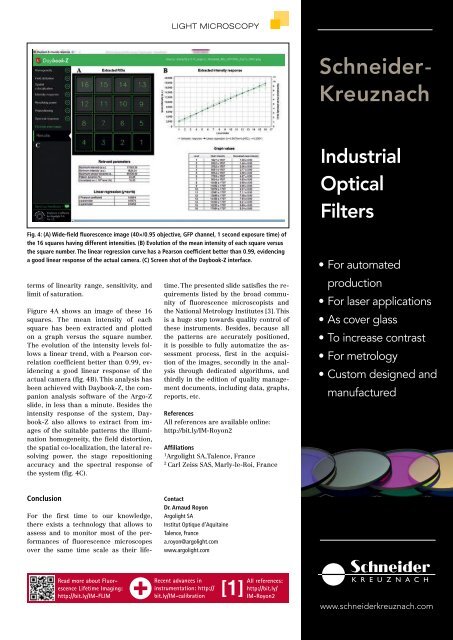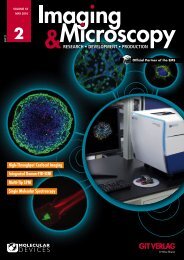SIM0216
You also want an ePaper? Increase the reach of your titles
YUMPU automatically turns print PDFs into web optimized ePapers that Google loves.
liGHT MICROSCOPY<br />
Schneider -<br />
Kreuznach<br />
Industrial<br />
Optical<br />
Filters<br />
Fig. 4: (A) Wide-field fluorescence image (40×/0.95 objective, GFP channel, 1 second exposure time) of<br />
the 16 squares having different intensities. (B) Evolution of the mean intensity of each square versus<br />
the square number. The linear regression curve has a Pearson coefficient better than 0.99, evidencing<br />
a good linear response of the actual camera. (C) Screen shot of the Daybook-Z interface.<br />
terms of linearity range, sensitivity, and<br />
limit of saturation.<br />
Figure 4A shows an image of these 16<br />
squares. The mean intensity of each<br />
square has been extracted and plotted<br />
on a graph versus the square number.<br />
The evolution of the intensity levels follows<br />
a linear trend, with a Pearson correlation<br />
coefficient better than 0.99, evidencing<br />
a good linear response of the<br />
actual camera (fig. 4B). This analysis has<br />
been achieved with Daybook-Z, the companion<br />
analysis software of the Argo-Z<br />
slide, in less than a minute. Besides the<br />
intensity response of the system, Daybook-Z<br />
also allows to extract from images<br />
of the suitable patterns the illumination<br />
homogeneity, the field distortion,<br />
the spatial co-localization, the lateral resolving<br />
power, the stage repositioning<br />
accuracy and the spectral response of<br />
the system (fig. 4C).<br />
For the first time to our knowledge,<br />
there exists a technology that allows to<br />
assess and to monitor most of the performances<br />
of fluorescence microscopes<br />
over the same time scale as their lifetime.<br />
The presented slide satisfies the requirements<br />
listed by the broad community<br />
of fluorescence microscopists and<br />
the National Metrology Institutes [3]. This<br />
is a huge step towards quality control of<br />
these instruments. Besides, because all<br />
the patterns are accurately positioned,<br />
it is possible to fully automatize the assessment<br />
process, first in the acquisition<br />
of the images, secondly in the analysis<br />
through dedicated algorithms, and<br />
thirdly in the edition of quality management<br />
documents, including data, graphs,<br />
reports, etc.<br />
References<br />
All references are available online:<br />
http://bit.ly/IM-Royon2<br />
Affiliations<br />
1<br />
Argolight SA,Talence, France<br />
2<br />
Carl Zeiss SAS, Marly-le-Roi, France<br />
• For automated<br />
production<br />
• For laser applications<br />
• As cover glass<br />
• To increase contrast<br />
• For metrology<br />
• Custom designed and<br />
manufactured<br />
Conclusion<br />
Contact<br />
Dr. Arnaud Royon<br />
Argolight SA<br />
Institut Optique d’Aquitaine<br />
Talence, France<br />
a.royon@argolight.com<br />
www.argolight.com<br />
Read more about Fluorescence<br />
Lifetime Imaging:<br />
http://bit.ly/IM-FLIM<br />
Recent advances in<br />
instrumentation: http://<br />
bit.ly/IM-calibration<br />
All references:<br />
http://bit.ly/<br />
[1] IM-Royon2<br />
www.schneiderkreuznach.com



